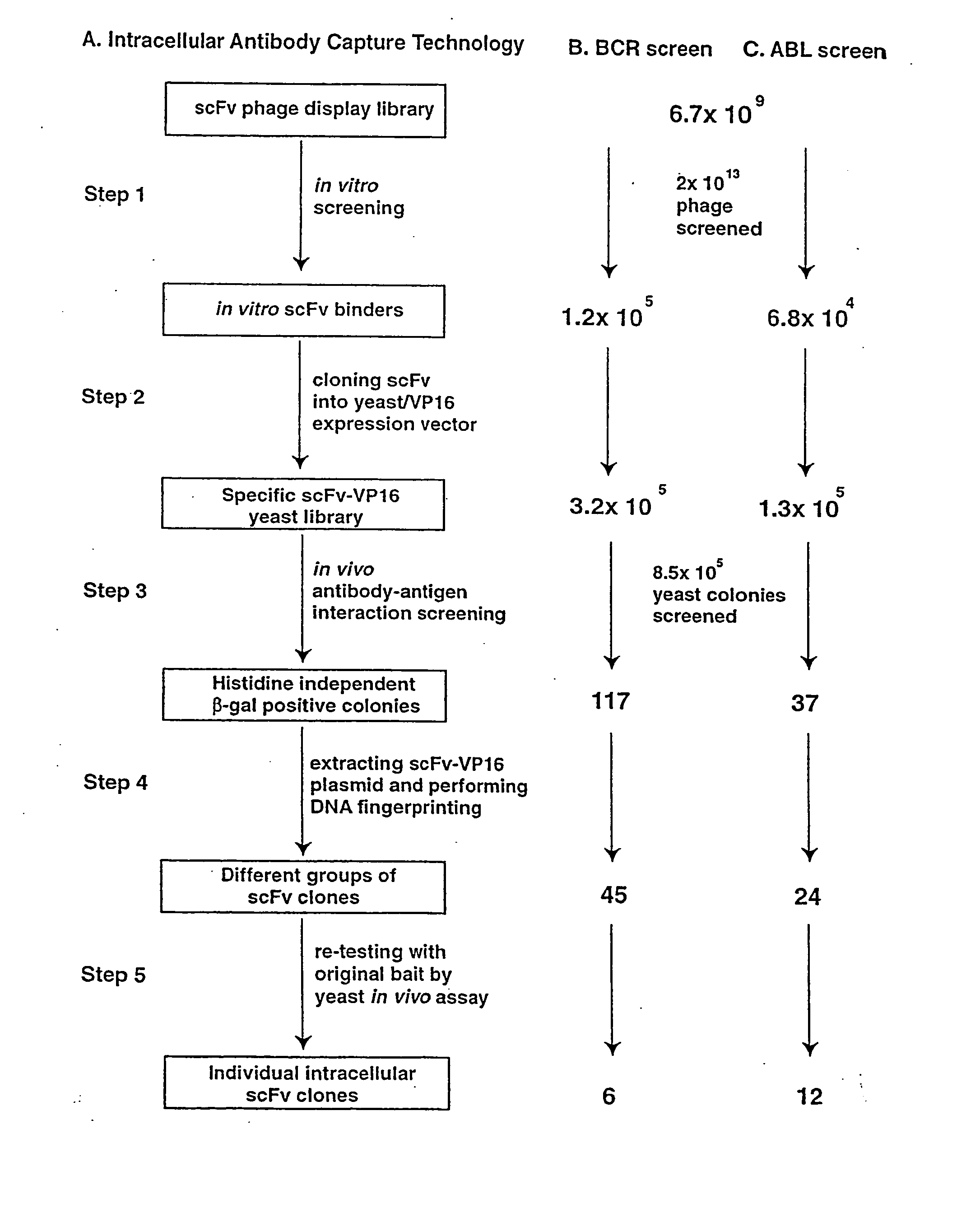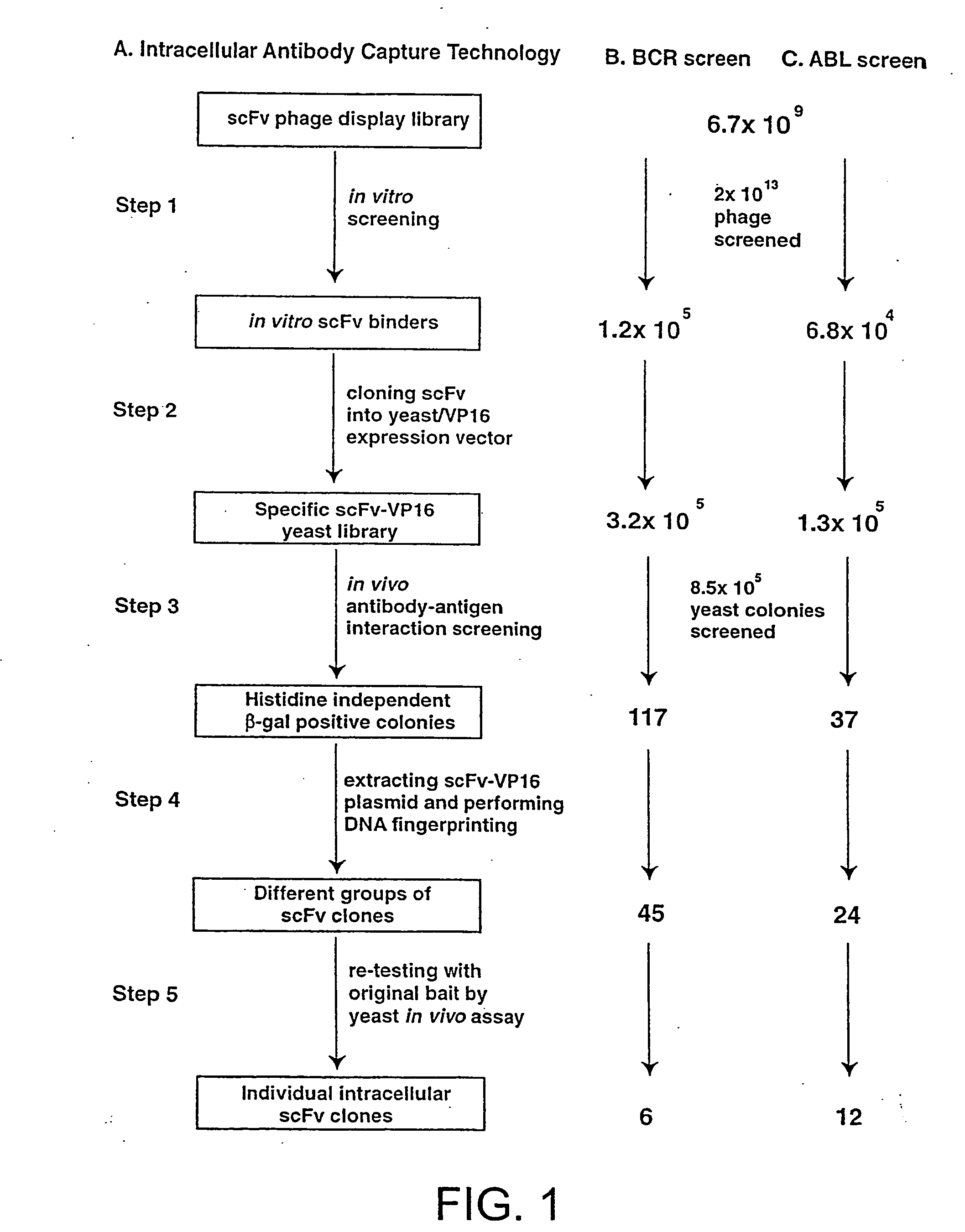Intracellular antibodies
a technology of intracellular antibodies and antibodies, applied in the field of intracellular antibodies, can solve the problems of limited half-life of antibody domains, low expression levels, and design of intracellular expression formats
- Summary
- Abstract
- Description
- Claims
- Application Information
AI Technical Summary
Benefits of technology
Problems solved by technology
Method used
Image
Examples
example 1
Bacterial Protein Expression and Purification Of Antigens
[0250] BCR antigen: A plasmid for expression of histidine tagged SH2 binding domain of BCR in bacteria, pRSET-BCRSH2BD, was made by amplifying the sequences encoding amino acids 185-417 of BCR and cloning the PCR product into mini pRSET vector (a gift from O. Perisic) as BamHI-EcoRI fragment.
[0251] ABL antigen: A plasmid for bacterial expression of histidine tagged ABL protein SH2 domain (amino acid 26-348) (pRSET-ABL) was constructed by PCR of the corresponding sequences and subcloning the PCR product as BamHI-EcoRI fragment into mini pRSET vector. PCR conditions were 30 cycles of 1 minute each at 95° C., 50° C. and 72° C. using specific primers (5′cagggatccgagcgcggcctggtgaag3′ / 5′ caggaattcatcgttgggccagatctg3′ for pRSET-BCRSH2BD and 5′cagggatccgaagcccttcagcggcca3′ / 5′caggaattccgagatctgagtggccat3′ for pRSET-ABL) and pE1A2 (BCR-ABL p190, a gift from Dr. G. Grosveld) as template.
[0252] The plasmids were transformed into E. co...
example 2
In vitro scFv Phage Display Library Screening and Preparation of SpecificscFv-VPI6 Yeast Library
[0253] A detailed protocol for the IAC methodology is described elsewhere (Tse, E., Chung., G & Rabbitts, T., H K, Turksen, Editor, 2000, Humana Press: Totawa). Purified His-tagged SH2 binding domain of BCR protein or the SH2 domain of ABL protein were coated onto immunotubes (Nunc) at a concentration of 50 g / ml in PBS for overnight at 4° C. 2×1013 phage displaying scFv (Sheets, M. D., et al (1998) Proc. Nat. Acad Sci, USA 95, 6157-6162) were incubated with the antigen-coated tubes and the bound phage were eluted with 100 mM triethylamine, neutralised by 1M Tris, pH 7.4 and were used to infect E. coli TG1 bacteria. The transduced bacteria were amplified by plating onto ampicillin supplemented agar plate from which phagemid DNA was extracted. The collected phagemid DNA was digested with SfiI and NotI restriction enzyme and the 700-800 bp scFv DNA fragment was gel purified. The purified s...
example 3
In vivo Antibody-Antigen Interaction Screening in Yeast
[0254] L40 Yeast (Statagene) was grown at 30° C. for 3-4 days, in YAPD medium (1% yeast extract, 2% Bacto-Peptone, 2% glucose, and 0.1% mg / ml adenine buffered at pH5.8) or in synthetic minimal YC medium (0.12% yeast nitrogen base, without amino acids and 0.5% ammonium sulphate, 0.1% succinic acid, 0.6% NaOH, 2% glucose and, as required, 2% agar) containing 0.075% amino acid supplements (lacking Trp, Leu, Ura, Lys, and His; 0.1% each of adenine sulphate, Arg, Cys, Thr; 0.05% each of Asp, Ile, Met, Phe, Pro, Ser, and Tyr) buffered at pH5.8. When necessary, 0.01% each of Trp, Ura, Lys, Leu and 0.005% His were supplemented to the media.
[0255] The bait antigen expressing plasmid comprised LexA linked to BCR-ABL (pBTM / EA2) was made by subcloning the 4 kb blunted EagI fragment of pE1A2 into BamHI blunted pBTM / 116 vector. For yeast in vivo scFv library screening, 1 mg of pBTM / E1A2 and 500 μg of the yeast scFv-VP16AD (where AD is acti...
PUM
| Property | Measurement | Unit |
|---|---|---|
| Fraction | aaaaa | aaaaa |
| Fraction | aaaaa | aaaaa |
| Fraction | aaaaa | aaaaa |
Abstract
Description
Claims
Application Information
 Login to View More
Login to View More - R&D
- Intellectual Property
- Life Sciences
- Materials
- Tech Scout
- Unparalleled Data Quality
- Higher Quality Content
- 60% Fewer Hallucinations
Browse by: Latest US Patents, China's latest patents, Technical Efficacy Thesaurus, Application Domain, Technology Topic, Popular Technical Reports.
© 2025 PatSnap. All rights reserved.Legal|Privacy policy|Modern Slavery Act Transparency Statement|Sitemap|About US| Contact US: help@patsnap.com



